- Just Spices is a German company that makes a series of flavorful seasoning powders, some spicy, some sweeter (like the new berry flavoring for yogurt) that are USDA organic and “sourced with love.”
The one for barbecue popcorn is a surprise – it gives your evening popcorn a barbecue flavor that doesn’t hit you like a ton of bricks, like many BBQ seasonings do. Especially if you pop your popcorn in coconut oil – so delicious – you don’t want to overwhelm it with spice. This BBQ seasoning is delicate yet definite enough to make your mouth pay attention.
Just Spices Mexican makes a salad special Just Spiaces – BBQ popcorn and Mexican flavors Serving idea – Mexican-spiced turkey meatballs with zucchini noodles The Just Spices Mexican seasoning is transformative. Now an avocado-studded taco salad – minus the beans and the meat – can be pretty delicious with just romaine, cilantro, red onion and salsa, topped with thickened 2% Greek yogurt (lower fat and calories than sour cream) and lots of fresh lime juice. Add a few drops of Habanero sauce and you’re good to go. But then, if you add a quarter teaspoon of the Just Spices Mexican seasoning, that same dish puts you on the sun-soaked hacienda of an elegant Mexican resort. And you immediately want to order a margarita with your salad. Even if it’s 8:30 AM. We also added it to our turkey meatballs and to the tomatoes we cooked ’em in and really enjoyed the whole thing.
Go try some of these. They just introduced 20 new flavors, too. You won’t go wrong buying one of their boxed sets as a gift for a hostess or friend who enjoys cooking but isn’t fanatical about making their own seasoning. These provide a shortcut that any non-professional cook – and maybe some professionals, too – will appreciate. Each individual package is 100 milliliters and priced from $5.99 to $7.99. Available online only at www.justspices.com/ -

Peter & Pat’s Pierogies make an easy dinner entree Peter & Pat Pierogies. And how about some low-fat, low-cholesteraol all-natural pierogies to back up – or be – your dinner entree? Peter & Pat love traditional Eastern European food so much they built it into a thriving catering business over the past 20 years. The most popular dish on their menu is the pierogies. In fact, theirs has become one of the top-selling pierogie brands in the United States. It’s been so successful they’ve now officially launched in Costco locations across the Midwest.
We can personally vouch for the flavor and filling ability of the 4-cheese-and-potato version they sent to test – delicious mix of creamy mashed potatoes with Cheddar, farmers, Parmesan and Swiss cheeses. Yet only 240 calories for four pierogies – not bad for so much creamy, cheesy goodness. Frozen bags of 4 pounds – that’s a lotta pierogies (65 per bag – 12 servings) – for $9.99 at Costco. -

molly&drew Mug Cake mixes and beer mixes are fun and easy molly&drew® Single Serve Mug Cake Kits come in four flavors include, Ooey Gooey Chocolate, Chocolate Sea Salt Caramel, Chocolate Raspberry Cheesecake, and Chocolate Candy Cane. Just add water, microwave for 90 seconds and ditch the need to mess up the kitchen. Fast, easy dessert for one or two. Top with whipped cream to make it more decadent.
molly&drew® also craft their own beer breads and beer cakes that let you blend your favorite beer into ready-to-go mixes. Try the beer bread for appetizers, main dishes, sides and desserts. There’s a cake mix, too, which we sampled – fun to make a cake with beer. We did, however, find the sizable dose of almond extract in the Amore Amoretto flavor somewhat overpowering. We left the cakes sit out for a day and the almond flavor diminished a bit. Still, what a fun – and EASY – idea for sharing with family and friends for brunches, barbeques, dinners, parties, sporting events and more.
Category Archives: beverages
The Symington family of fine port wines

Interestingly, port wines often do not state vintage years. Instead, when a wine is particularly good one year, it is “declared” a vintage after it’s been bottled. Because differences in weather are unpredictable every year, only great years can command a declaration. It is always an exercise in self-restraint for port winemakers to decide which years deserve to be declared.

Some of the biggest names in port from the Douro Valley are all owned by the Symington Family Estates. Cousins Rupert and Charles Symington came to Chicago recently to introduce their exciting 2015 vintages and showcase a few of their older premium offerings.

Our favorite among all was the Cockburn’s 2015 Vintage Port, its bicentenary vintage. The Symingtons purchased Cockburn’s from the company that had been operating it since the family sold it in the 1950s – to the detriment, they believed, of the fine brand. “We wanted to bring back the spirit of Cockburn’s,” said Rupert. So they organized a tasting of some of the very oldest Cockburn’s vintages – from 1912, 1920 and so on. They knew, then, what their goal would be to engineer the re-birth of the Cockburn excellence. Their 2015 has lush aromas and flavors of maraschino and black cherry that eventually turn into Kirsch-like flavors. Rupert described it as “tropical jungle.” The 2011 vintage port is a perfect example of this super-refined structure and power of the Cockburn port profile: dark, brooding, powerful.
Profile – Rémy Martin Cellar Master Loiseau

The message is clear: Rémy Martin XO Cognac, savored slowly, yields oh-such-rich rewards. Baptiste Loiseau is young to be in charge of creating some of the finest Cognacs in the world. At 36 – tall, slender, handsome and impeccably groomed – he is the youngest Cellar Master ever to be appointed to the Rémy Martin house of fine Cognacs. And he’s earned that place, learning at the right hand of Rémy Martin’s then-Cellar-Master after having already paid his dues studying wine making around the world.

But his heart was drawn back to Cognac. Having experienced the rich multitude of aromas emanating from those small copper pot stills full of eau de vie, he wanted to learn what was going on in there. So his next step was to spend two years researching the connections between grapes and eau de vie. And that’s when Rémy Martin invited him to join their team, led by their Cellar Master – actually, Mistress. She took him under her wing and taught him everything she knew about how to turn eau de vie into the distinct style of Rémy Martin. He spent seven years under her expert tutelage, learning how to select the eau de vie, determine the quality of the cask, and make the blends. “She was like my mother at work,” said Baptiste.
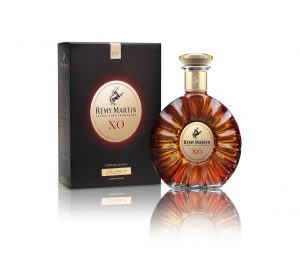
Okay, what’s the right way to taste the finest Rémy XO? You must take your time, says Baptiste. The aromas reveal themselves gradually as the liquid sits in the glass. First, you will notice some fruitiness. Then comes the richer flavors of nuts. And later, the surprise of complements to dark chocolate. “Do you keep the chocolate in your mouth when you taste the Cognac?” He nodded and watched my surprise as I experienced an explosion of flavors and sensations all around my mouth – utterly delightful. He smiled. “That is what happens when you combine dark chocolate with XO. But you have to wait a while. The right complementary flavors and aromas are not released until the liquid has been in the glass for a little while.”
“The floral notes don’t reveal themselves until the spirit has aged at least 10 years,” he said. “The bitterness of the chocolate highlights the softness of the spirit.” He kept murmuring: “butterscotch, oranges, rich, yeasty brioche…” It was a pleasure to see how deeply involved he was in experiencing and naming all the complexities of this magnificent Cognac. Gives the rest of us something to aspire to.
Besides the XO, Rémy Martin makes a VSOP that exhibits a harmony of flavors like vanilla and dried apricots. 1738 expresses nuts and vanilla. If you’re looking for a luxury gift for your Cognac-loving dad or grad, you won’t go wrong with Remy Martin.
Wine in cans, organic spirits, and real-fruit sparkling water

Backpack canned wine. You’ve heard of boxed wine, of course, and a number of makers are putting out some excellent quality in that formerly-scorned-but-becoming-more-popular packaging. Now comes wine in a can. Backpack Wines, based here in Chicago, recently put out two blend varieties: Cheek Rosè® and Snappy White®, in four-can packs. Made with grapes from quality vineyards, the wines come in recyclable cans you can take anywhere with the same convenience you get from canned beer or soda. We’re not talking luxury wines here, but the taste is reasonable and the convenience unbeatable. Chill a few cans for your next barbecue, picnic, beach outing – or just sip one with a friend sittin’ on the patio on a summer evening (yes, summer is going to hit with a vengeaance any minute).

Prairie organic spirits. Another new player in the alcoholic beverages category is the line of Prairie organic Spirits. “Made with respect from seed to glass,” Prairie Organic Spirits offers 100% certified organic vodka, made from a single-sourced, organic corn grown on a handful family-owned and operated Minnesota farms. Each bottle of Prairie Organic Spirits takes three years of meticulous work. The Cucumber version we sampled gives off lovely and unmistakable aromas of fresh cucumbers. Immediately upon opening the bottle we imagined making our favorite chilled gazpacho or Bloody Mary recipe spiked with this pure, unadulterated spirit. It’s also great as a mixer with flavored sparkling water or in your favorite cocktail. Without question will increase the aromatic intensity of whatever you use it in.
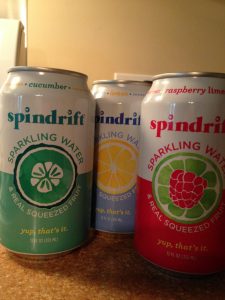
Spindrift fresh-squeezed-fruit-flavored sparkling water. It’s always important to stay hydrated, but it can be problematic if you don’t enjoy plain water. And there’s some evidence that neither sugar nor artificial sweeteners are very healthy, so here’s a new option: sparkling water made with real fruit. Spindrift is the only bubbly that uses real fruit to flavor its water. It’s refreshing on its own or a great mixer for summer cocktails. These waters are flavored only with 100% organically grown fruit – juice and purée. We love the fruit aromas and the bubbles of all the flavors. Now imagine topping up a shot of Prairie cucumber vodka (above) with ice and a few ounces of cucumber Spindriftr sparkling water – and top it with a spring of mint. Hard to get more refreshing than that. Comes in blackberry, cucumber, grapefruit, orange mango, lemon and – our favorite so far – raspberry lime.
Cafe Brauer – good food, cocktails and great views

Lincoln Park has a number of interesting places to eat, and I just discovered the pleasure of one of those – the patio at Cafe Brauer. Delicious American food specialties, served by warm and friendly people, and a small selection of wines, craft beers and cocktails designed to satisfy most of us. One menu item promises fresh vegetables from Green City Market, one of the city of Chicago’s markets that sets up every Wednesday and Saturday nearly across the street on Stockton Blvd. This is a marriage made in heaven.

Entrance to the Nature Boardwalk is right off the patio. You can walk all the way around its half-mile perimeter as it wends through a 14-acre nature preserve. It’s a closed pathway, so you can trust that your bicycling or dog-walking grandchild or friend will definitely find her way back to you. No way to get lost. Being in “the wild” in the middle of the city without being worried you’ll get lost. Can’t wait to bring my granddaughter here.
Mallard duck pairs occasionally break the still waters of the pond next to the patio. It’s an incredibly peaceful and calming environment. Bird song everywhere. People walking.

The Cafe Brauer patio is the site of many weddings, school and corporate events. The staff are highly experienced at providing buffets full of tasty all-American foods like buttermilk fried chicken (delicious!). The regular menu offers big plates to share – calamari, wings, guac and salsa, or steak chili nachos. Then there are soups and salads, plus paninis, burgers – including turkey and black bean and classic sandwiches, all served with fries. Sides are interesting – side salad, Parmesan fries, waffle-battered sweet potato fries with maple-vinegar aioli, mac & cheese, and stir-fried Green City Market vegetablea, all priced at $4.95, but if you order them with a sandwich they’re only two bucks. Desserts are $5.95 and include Brownie Sundae, Blueberry Crisp, and Cookie Skillet with ice cream. Hungry yet?
Basically, Cafe Brauer has just about anything your heart could desire. They even play upbeat music at just the right decibel level – cheers the atmosphere and lightens the spirit.
Redeem yourself on Dad’s day – toast with Redemption Whiskey
We are big fans of distilled brown spirits of all types. And if you happen to be, as well, Father’s Day is a great excuse to splurge on a really nice bottle. But, then, so is Memorial Day, or summer, or Saturday, or… Heck, who needs an excuse anyway?

Redemption Whiskey. The bold, flask shaped bottle is a perfect fit for the hardworking Dads in our lives, and the story of the whiskey is right on the label.
Redemption Wheated Bourbon ($44.99; 48% ABV) – NEW! This new limited edition offering, coming June 2017 just in time for Father’s Day, is harmonious on the palate, delicate, yet robust and intense. Most Wheated Bourbons have between 20% and 30% wheat in their mash bill while Redemption has 45%. Flavors of roasted coffee bean, smoked meats and hazelnut marry harmoniously with spicy notes of cardamom and black pepper and a fresh hint of mint. Deep topaz and amber with hues of orange and lime.
Redemption Rye ($29.99; 46% ABV) – A true expression of the rye grain, beautifully flavored rye spice with light floral and citrus notes. Slight mint finish makes this great or sipping or mixing in a classic cocktail.
Redemption Bourbon ($29.99; 42% ABV) – The high amount of corn gives this bourbon a classic sweet taste with notes of vanilla and caramel from the wood, and the rye adds some light spice flavor. Bottled at 84 proof for a lighter experience, great on the rocks or in mixed drinks.
Wisdom from Jackson Family winemakers – Masters of Oregon Pinot Noir

If you’ve ever thought a Pinot Noir from Oregon tasted like a Burgundy, you’re not alone. Though half a world away from each other, both regions are located on nearly the same latitude and many winemakers in each area practice similar vinification techniques. Early makers of Pinot Noir in America had to go to Burgundy to study because no wineries here were making Pinot Noir at the time. Willamette Valley has been focusing on Pinot Noir for the last 51 years, and its capricious weather keeps winemakers on their toes.

Below is a glimpse into the collective wisdom of these passionate and skilled winemakers – a somewhat loose arrangement of interesting bits about winemaking from the half-dozen panelists – who were, by the way, having more fun up there than we’ve ever seen in a wine tasting program!
- The soils in Willamette (pronounced Will-am-it, dammit) are actually oceanic, which is really good for growing Pinot Noir grapes. As the earth’s tectonic plates scraped against each other creating mountains in that area, they dislodged soil that was formerly at the bottom of an ocean and deposited that in the valley between the two mountain ranges, Cascade and Coast that both influence the environment and protect the grapes that grow here.
- In 1988 there were only 49 wineries in Oregon. Now there are 700.
- Unlike in Napa Valley where many owners don’t live, Jackson Family winemakers live on site. They also meet regularly and readily share information with each other. For example, when one grower decided to try earlier thinning than tradition, he readily passed along the results: vines mature better and the grapes have more flavor.
- California, Oregon’s southern neighbor, is too warm to grow Pinot Noir grapes. It seldom has difficult growing seasons, whereas Oregon’s climate is a constant challenge to wine growers.
- Julia Jackson, born in Sonoma, said her mother had a vision of going to Oregon, and then the whole family fell in love with wines grown there. Julia herself loves being out in the vineyards, being stewards of the land, a sense of discovery about the great wines. Jackson Family winemakers also believe in educating visitors and so sponsor collaborative trips for that purpose.
- The grapes in Willamette are more transparent than those grown in Burgundy, yet the finished wines can easily be aged 10 to 15 years. Burgundy has many different producers. Willamette offers multiple mesoclimates. Producers must be in intimate touch with the features of their terroir, and most consider their big markers as the specific site and the vintage – yielding wines with a rustic nature and a nice backbone of tannins. Even though Oregon Pinots have a darker profile, they tend to be fresher and more acidic than California’s.
-
Napa is most known for its Cabernet; Willamette is identified with Pinot Noir; Argentina with Malbec. La Crema was the first Jackson Family winery to move into Oregon. They definitely don’t try to make a California version of Pinot, but rather work on discovering what’s there and stay true to that. Willamette’s vintage-to-vintage variability necessitates constant continuing education. Jackson Family winemakers are required to dedicate 5% of land to biodiversity as part of the goal of keeping the land healthy.
- Lots of volcanic soils are good for winemaking and viticulture. They have greater water holding capacity. Results in plush, fruit-driven wines. Sedimentary soil (as in Willakenzie) drains more freely. Vines struggle more, resulting in wines that are a bit more rustic, firm, structured. Oregon has only these two soil types – sedimentary and volcanic. California has many more soil types than France.
- Wind is a moderating influence, and in Oregon it is significant. The last two wines listed below are grown in seriously windy areas. Zena-Crown is in the Van Duzer Corridor, where the same strong wind blows all year, even on 90-degree days. “We pick 2-3 weeks later, because vines shut down at night. It’s always been a truism that we can’t plant above 1000 feet, but now we’re considering it because the summers have been so much warmer. Skins get thicker from the wind – which helps grapes defend against weather. Keeps higher acidity, which equals freshness and tannins.” Read more about the cool-climate growing conditions in Willamette Valley.
- Siduri Willamette Valley 2015. ***1/2 This Pinot is made with a blend of three different regions, uses 25% whole cluster (means they keep the grapes on their stems) and is made using Burgundian vinification techniques. Winemaker notes: “Darker berry and currant flavors, along with hints of cherry joined by earth, dried brush, and even tobacco flavors.” SRP ~$24
- WillaKenzie Gisele Willamette Valley 2014. **** Blended to produce a rustic, brambly fruit flavor. Winemaker notes: “Juicy acidity and flavors of raspberry, plum and a hint of white pepper. The mouthfeel is elegant and polished with a long, velvety finish.” SRP ~$24
- Penner-Ash Willamette Valley 2014. ****1/2 A gorgeous dark purple color but transparent. Jammy flavor. Winemaker notes: “Experience ripe, fresh raspberry, red plums and strawberry compote with a hint of subtle cedar. The fine texture and silky tannins enhance the vanilla, brown sugar, and leather notes on the finish.” SRP ~$40
- La Crema Dundee Hills 2014. ***** Purple/garnet color with a mid-palate richness. Grown by the independent Oregon contingent of this famed La Crema California winery from two clones in an area sheltered from the winds, so with a longer growing season. This vineyard has 18 different soil types within its 80 acres. Winemaker notes: “A nose brimming with violets, cherry pie and earth. Flavors of pomegranate, raspberry and anise. Nuanced yet concentrated.” SRP ~$50
- Gran Moraine Yamhill-Carlton 2014. ***** Another wine made with 25% whole cluster. Lovely pink-purple color. Winemaker notes: “Cranberry and rose hips up front that transform into orange zest and Meyer lemon on the mid pallet. This is followed by morel mushroom, red cedar, and exotic spices as allspice and mace. Precise but broad; exhibiting restrained power and elegance combined with immense aging potential. Finish lingers giving impressions of pipe tobacco, earth, white sage and pure cocoa. Shaped like a teardrop rippling outward at the point of contact with a still body of water.” SRP ~$45
- Zena Crown Slope Eola-Amity Hills 2013. ***** Couldn’t put it better than Wine Spectator’s 93-point rating – “Rich and expressive, featuring black cherry and pepper notes set against tangy mineral flavors. Comes together smoothly as the finish gains traction, with a light bite of tannins. Drink now through 2023. 348 cases made.” SRP ~$100
Trader Todd’s shows off its brunch chops
If you know Trader Todd’s, 3216 N. Sheffield, you may think of it mainly as a karaoke joint with tiki-bar-style drinks and atmosphere. But guess what? They are now doing brunch, and their Executive Chef Mark Hill really knows how to put food on the plate, with here and there his own unique touch to dishes you thought you knew.

For example, ever ordered fried chicken and waffles? It’s always seemed like a stretch to understand what makes the two go together. But Chef Hill has changed that up for many Trader Todd brunch customers. The way he combines these two is totally unique – kind of like eating your main course and your dessert at the same time. The waffle has a sweet crunch, and the chicken comes in chunks bathed in a rich, brown, slightly sweet-spicy jerk sauce sparked with Chef’s own mixture of allspice and peppers and maybe some or all of these: cloves, cinnamon, scallions, nutmeg, thyme, garlic, brown sugar, ginger, and salt. It’s his secret – and it’s a good one.

And lest you wonder about the kitchen’s ability to do standard brunch items up right, check out the lovely omelette, cooked so that the eggs come out tender and moist rather than dry and tough. Get your choice of cheeses and fillings and eat ’em with the kitchen’s house-made fried potato chunks – tender inside and just enough crust on the outside. Delicious.
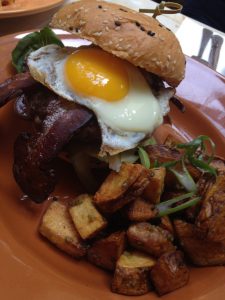
Or if you’re in the mood for a burger, Trader Todd’s does ’em good. Nice helping of ground beef, grilled and served with whatever toppings your heart desires. And some more of those good fried potato chunks. But don’t stop there. They’ve got Benedicts and sliders and conch cakes, Jerk Chicken and Jerk Pork sandwiches and more. It’s pan-tropical food and drink to make you feel like you’re in the islands. Lots of open-air space, and there’s even a boat you can sit in in the back bar. It’s a faux-island paradise for brunchers to start off a Saturday or Sunday of relaxation.
Maggiano’s does brunch Italian-style
Why brunch, you ask? Because there’s no longer any doubt that brunch in America has become a special occasion in its own right, and Maggiano’s is all about helping you make your occasions special. They now open at 11 on weekends to satisfy your brunch cravings with their own unique take on traditional brunch features and a few surprises of their own. Naturally, because libations are a critical component of the good brunch, order your favorite Bloody Mary – Italian-style with a distinctive Maggiano’s flavor – mimosa or peach Bellini. The full bar selection – from champagne to whiskey – is available if you prefer your drinks unmixed.
Another these-carbs-are-so-worth-it! dish is the Crème brûlée French toast. Made with cranberry-raisin bread, it’s got the creamy, rich flavor of the restaurant’s house-made Crème brûlée mix and is another great way to enjoy helpings of strawberries, blueberries, whipped cream and syrup.

Veggie frittata features smoked Gouda, spinach, mushrooms – fresh flavors, softly finished eggs – served with crisp Vesuvio potatoes. You can also choose from the can’t-eat-anymore Italian breakfast of three eggs with ham, bacon and Italian sausage plus potatoes.
- Meatball Benedict – surprising combination. Nice tomato chunk balances richness of egg yolk and Hollandaise with the flavor of the sturdy beefy meatball. The Italian woman at our table – who, of course, makes her own meatballs – couldn’t stop talking about how much she appreciated how these meatballs worked with the Benedict formula. Hey, if an Italian approves…
- The Chicken Francese Benedict takes a popular item from the regular Maggiano’s dinner menu – lightly breaded chicken that’s fried and served with arugula – and turns it into a house-made Benedict special.
- The regular Eggs Benedict is served with a uniquely flavored ham made locally and shipped in from Wisconsin – Nueske’s, which also makes the thick, juicy bacon served at brunch.
- Crab cake Benedict – nice combo. A pleasantly standard crab cake mixture blends well with the Hollandaise and egg yolk.
All Benedicts are served with house-made crispy Vesuvio potatoes – a deliciously salty preparation that was slightly undercooked on this occasion. If you’re a stickler for thoroughly cooked-through potatoes, make sure to ask your server to tell the chef to make them extra crispy.
2 new rums and a Chile liqueur

Rum is one of those drinks that can vary wildly in taste and smoothness. Some of the best are so smooth and delicious they can be enjoyed neat – like brandy/cognac, sipped as a post-prandial libation or nightcap. One of the leaders in the rum game is Captain Morgan, and they make a dozen different varieties from spiced (love it!) to regular to tropical flavored and super-premium. Below are a couple of rums and a unique chile liqueur we just learned about.
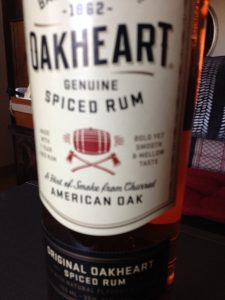
Oakheart Spiced Rum from Bacardi is delicately but richly spiced and tastes utterly lovely all by itself, even without ice. In a recent blind taste test, results indicated Oakheart won out over Capt. Morgan, but of course, you must judge for yourself. Oakheart is a clear winner for our nightcap needs around here. Love the subtle layers of flavor and the gentle spicy warmth going down.
Uh, yeah. You can mix this with cola, but we think it’s a shame to drown all these flavors: “characteristics of oak barrel staves with the essence of bourbon or brandy, a hint of smoke from the charring process, background notes of dried fruit and heavy delivery of sweet creamy butterscotch. Notes of custard, maple and honey flavors [emphasis ours!] coat the tongue and [the drink] finishes with a touch of pepper.”
Havana Club Añejo Clasico Puerto Rican rum is a dark rum with oaky hints of vanilla and almond, along with fruity notes akin (think pineapple and apricot) with a robust and velvety finish. It’s really good in mixed drinks like the one in the recipe below. Perfect with a weekend brunch or a fireside session.

The 8th Day
- 1 ½ parts HAVANA CLUB Añejo Clásico Puerto Rican Rum
- 3 parts Chai tea
- 1 ¾ parts coconut milk
- 1 part simple syrup or 1 tbs white sugar
Method: Prepare Chai Tea. While the tea steeps, warm coconut milk over medium heat, do not boil. Combine ingredients in a high temperature resistant mixing glass, adding rum last and stir. Serve in an Irish Coffee Cup or preferred glass coffee cup, and garnish with a cinnamon stick.
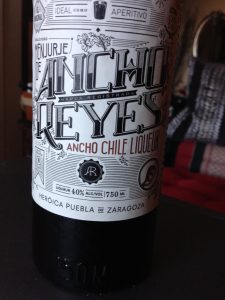
And then there’s the unique Ancho Reyes Chile Liqueur from Puebla, Mexico. It’s good for after-dinner or aperitif, depending on your mood and your menu. This has been a favorite around here since we received the review sample. Thick and creamy, dark amber color, heat and peppery flavors make this a unique experience for your tongue and nose. Maker’s notes say: “Pleasantly sweet, followed by chile with moderate heat and slight acidity. Hints of spices, tamarind, plum, cacao, apple and almonds then subtle notes of fine herbs. A pleasantly lingering pungent taste on the finish.” Works for us!














